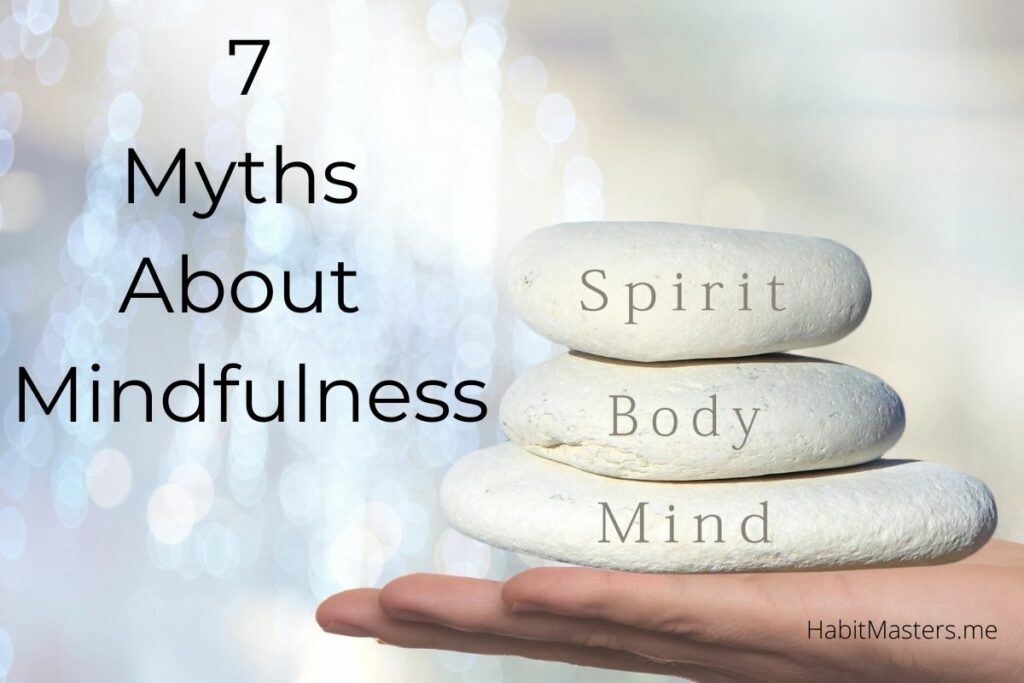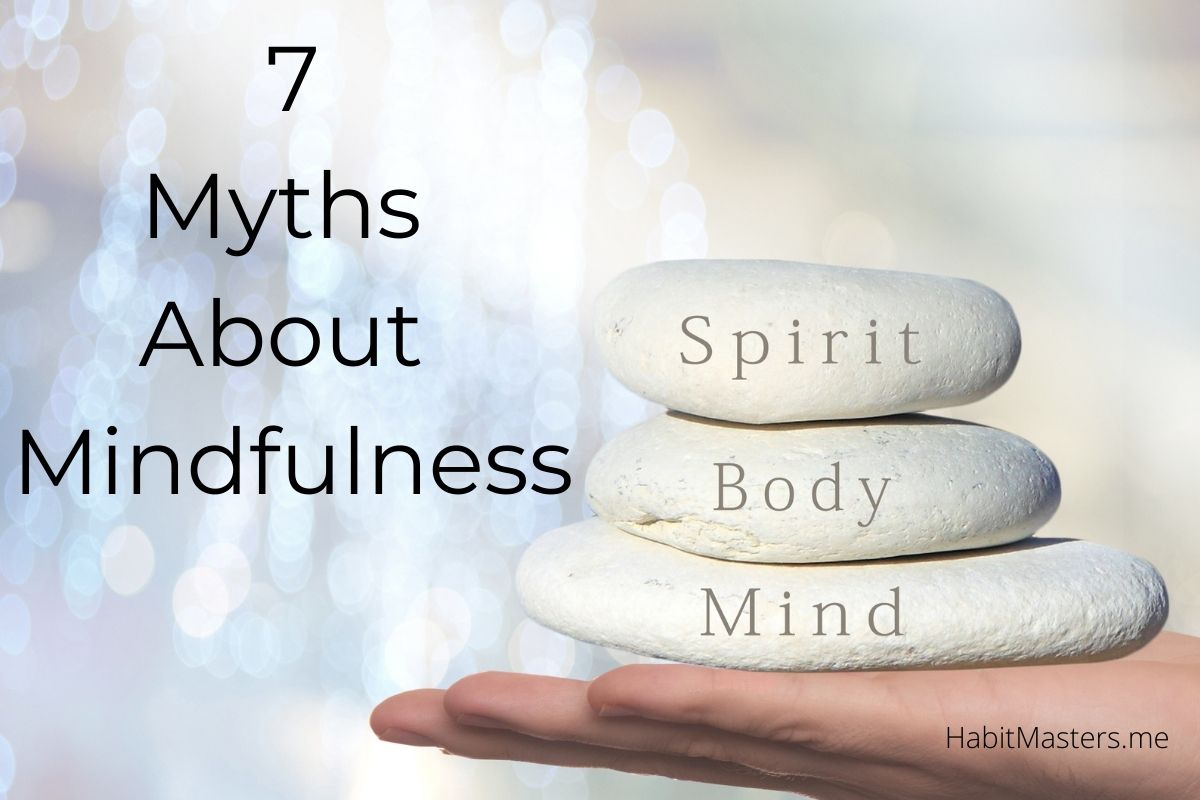The world is a crazy place right now and stress levels are collectively higher than ever. You know you have to do something and you’ve heard of mindfulness, but you don’t really think it can work for you.
Most people think that mindfulness is synonymous with meditation and it is, sort of.
Others think it’s just “trendy” and this too shall pass and that too is true…to a point.
Mindfulness does incorporate meditation…if you want….and it is trendy because it works to help many people diminish the impact of stress on their minds, bodies, and spirit.
In this article let’s review some of the most common myths about mindfulness and how these myths are keeping you from embracing an amazing practice.

What is Mindfulness?
Mindfulness is the practice of self-awareness. It is a process of paying attention to one’s body, thoughts, and feelings in the present moment without judging them good or bad.
It is a practice that teaches us to be more compassionate to ourselves and others.
Mindfulness can be compared to meditation where one focuses on the breath and body sensations.
Meditation is often practiced for a few minutes at a time, but mindfulness can be practiced for as long as one wants.
Meditation is often used to help reduce stress levels while mindfulness can be used for many other reasons including mental health conditions such as anxiety or depression.
Mindfulness Myth #1: Mindfulness Means Sitting Uncomfortably
Many people think that mindfulness means meditation and meditation means sitting in a super uncomfortable position for a very long time and then not being able to walk afterward.
But mindfulness is really just about being aware of the present moment.
So you can practice mindfulness anywhere. Mindfulness can be practiced while eating while walking while driving while in the shower.
Mindfulness can be practiced sitting on the floor, sitting in a chair, lying in bed, or standing on the street.
Mindfulness Myth #2: Mindfulness Conflicts With My Religion
The conflict between mindfulness and religion is a common one.
Many people who practice mindfulness are often asked, “Isn’t that against your religion?”
There is a misconception that mindfulness IS Buddhism, but it is not.
Mindfulness is part of Buddhism, but it is also part of most religions.
Mindfulness and meditation are secular practices that can be used to deepen your spirituality or not. It’s up to you and how you choose to use this amazing tool in your life.
Mindfulness Myth #3: I Must Keep My Mind Blank
Most people that have tried mindfulness and quit do so because they believe that they have failed because they cannot keep their minds blank.
Mindfulness is really about staying present and realizing when your thoughts have wandered off and bringing them back to the present.
So keeping your mind blank at all times isn’t the goal.
The goal of mindfulness is to notice the wandering and bring your mind back to the present.
Mindfulness Myth #4: I Tried It Once, It Didn’t Work For Me
Another myth I hear is that people tried mindfulness that one time and it didn’t work for them.
Mindfulness is a practice and that means it must be done regularly in order to see the benefit.
So “doing mindfulness” one time will not create the same benefits that having a daily mindfulness practice can have.
Mindfulness may have many benefits such as:
- reducing depression and anxiety
- improving memory, focus, and cognition
- lowering blood pressure
- reducing pain
- improving sleep
and many, many more.

Mindfulness Myth #5: I Don’t Have Time
Another big myth of mindfulness is that it takes an extended amount of time.
Mindfulness can be practiced in as little as 30-second blocks throughout your day.
When you wake up in the morning take to take three deep breaths – count to 3 on the inhale and 6 on the exhale.
In the shower, you can focus on how the water feels on your skin. While you’re driving take more deep breaths every time you come to a red light.
While it is helpful to have a dedicated time to practice, mindfulness can be practiced throughout your day.
Mindfulness Myth #6: It’s Just For Monks Not “Average” People
Mindfulness is not just for monks. This practice is now popular among people of all ages and backgrounds.
Because people think of mindfulness and meditation as one thing, it can be a bit intimidating when you think of how long monks sit and the type of practice and willpower it takes for them.
As I’ve mentioned previously, the practice of mindfulness is really just about being aware in the present moment which means that anyone anywhere can practice mindfulness

Mindfulness Myth #7: It Must Be Done in a Quiet Place
Mindfulness is a state of mind in which one focuses on the present moment, letting thoughts and feelings come and go without judgment. This state does not require a quiet place.
But I will admit, it is easier to practice mindfulness meditation in a quiet place. This will help you focus on your breathing and be aware of your body and environment.
What’s Next?
Mindfulness is more than just taking a few deep breaths and suddenly becoming a happier healthier person.
Mindfulness does take practice and dedication, but the payoffs can be life-changing. Hopefully, I’ve addressed some of the myths about mindfulness and you are prepared to give it a try.
But where do you start?
There are MANY guided meditation videos on Youtube (like the one above) and tons of apps (Headspace, Calm, Insight Timer to name a few) that can help you with your daily practice.
But you can also just sit quietly for 1 minute and then work up to 2 minutes and then 5 minutes and so on until you feel that you have a practice you can sustain.
I’d love to invite you to join my Habit Masters Membership where we’ll work on building healthy habits by establishing a mindfulness practice, establishing healthy eating habits, and including movement daily.

Leave a Reply